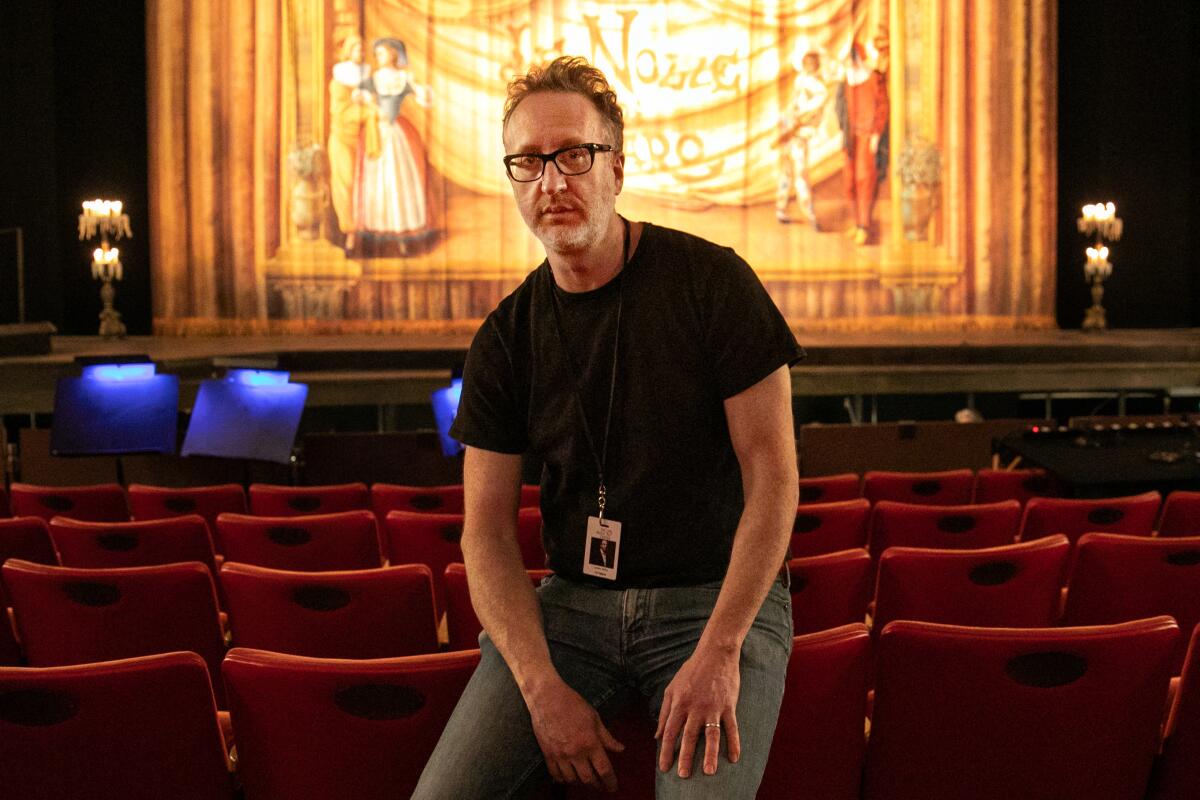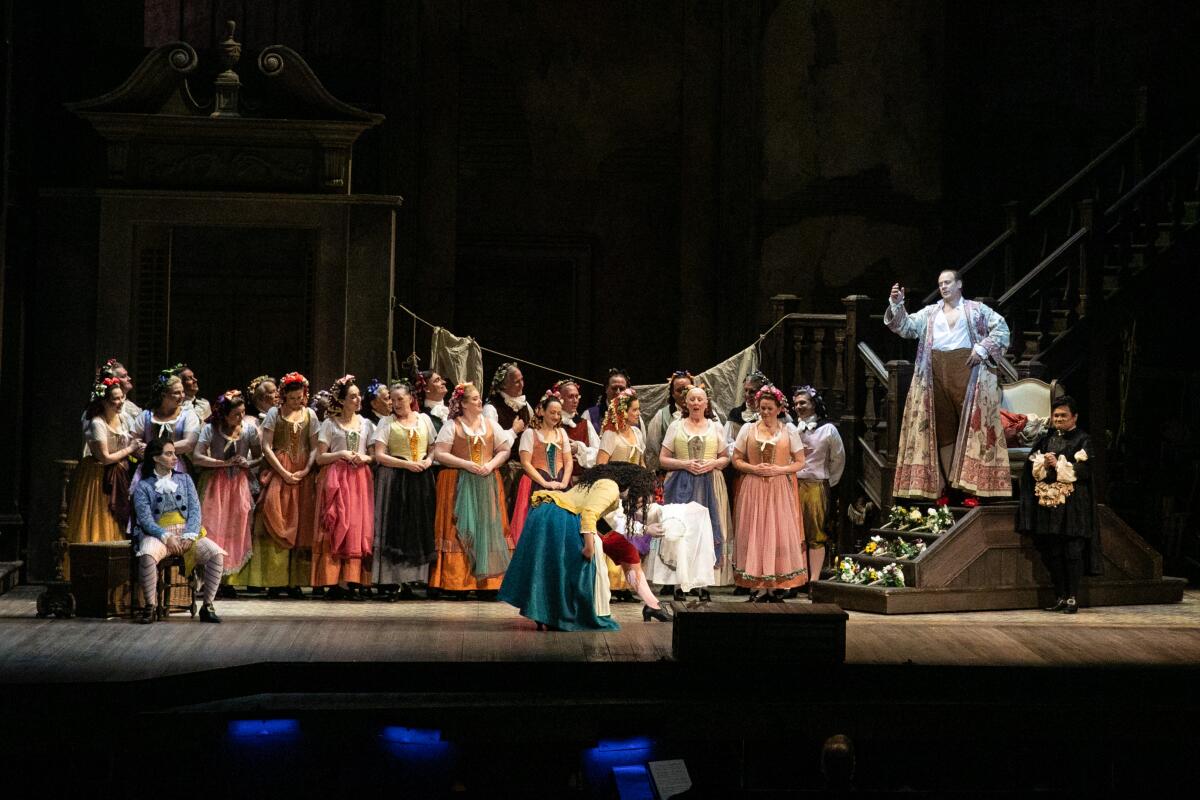From “Armageddon Time” to arias: Hollywood filmmaker James Gray on directing his debut opera

- Share via
James Gray had opera playing while he wrote the screenplay for his latest film, “Armageddon Time,” specifically a guitar version of Mozart’s “The Marriage of Figaro.” And he directed his cast — which included Jeremy Strong, Anne Hathaway and Anthony Hopkins — almost as if he were directing opera. That involved using “a more basic, ground-up approach to talking to the actors,” Gray says, “constantly about intention, and trying to get to the core of the scene.”
That’s because, just prior to shooting “Armageddon Time,” Gray directed his first opera (“The Marriage of Figaro,” in fact) at the Théâtre des Champs-Élysées in Paris. One protracted pandemic delay later, he’s now bringing the same piece to L.A. Opera, opening this weekend at the Dorothy Chandler Pavilion.
Although he’s a lifelong opera fan, Gray, 53, didn’t seek out “Figaro,” — which “was not even my favorite Mozart opera,” he admits, sitting in a quiet nook on the second floor of the Dorothy Chandler Pavilion. “My favorite is ‘Don Giovanni.’ But now that I’ve done it, I think maybe ‘Figaro’ was the greatest.”
“I love just trying to examine what those guys did in the late 18th century,” he continues. “Very subversive, what they did. Because Contessa and Susanna have tremendous say in the story. Their identity and their feelings matter hugely in the narrative, and what the opera is saying about their roles in the world is pretty revolutionary.”

Gray is known for his dramatic, empathetic character studies in films such as “The Immigrant,” starring Marion Cotillard as a Polish woman who comes to a rough New York in the 1920s, and “We Own the Night” with Joaquin Phoenix as a nightclub manager in the rough Brooklyn of the 1980s, as well as characters going on grand odysseys in “The Lost City of Z” and “Ad Astra.”
He approached his debut opera not with the radical vision of an auteur filmmaker but rather with an almost sacred reverence for the art form and this libretto — written by Lorenzo Da Ponte 237 years ago — about a rich and lustful count trying to steal his servant’s fiancé, and the young couple’s schemes to thwart him.
Gray jokes about “imposing his vision” on the opera by, say, putting the characters in outer space aboard the Death Star from “Star Wars.”
“I don’t think that’s what I was brought here to do,” he says. “I was brought here to stage it, and to coax the singers into the best dramatic depiction possible of their characters, who already have their roots in the libretto and in the music.”
A peek at a rehearsal of his work revealed an intensely faithful staging of the Mozart classic — of relational hijinks and hanky-panky couched in sticky melodies, sung by a cast including Janai Brugger as Susanna and Craig Colclough as Figaro, inside a very traditional set. It was like taking a time machine back to Mozart’s Vienna in 1786.

Describing his responsibility as the director is tricky, Gray admits, because “if I could verbalize it, it wouldn’t have to be opera. It exists because music is the most direct path to the human heart, combined with behavior that we recognize — even as outsized as it is — and it recognizes and acknowledges the extremes of our soul. That’s what transcendence is. That’s what art’s here for. That’s why I like opera.”
He didn’t always. Growing up in the Fresh Meadows neighborhood of Queens — “No fresh meadow anywhere,” he says dryly — Gray remembers going to Manhattan with a group of — “I hate to use this word” — underprivileged public school kids to see a dress rehearsal of “Aida” at the Metropolitan Opera.
“And I hated it, of course,” he says. “I thought it was very boring.”
(The conductor that day was James Conlon, who is conducting Gray’s production of “Figaro.”)
Jean Nouvel, Gustavo Dudamel have designs on ‘Marriage of Figaro’
He found love for opera through the movies — films like “The Godfather” and “Raging Bull.” The first opera CD he bought was a 1977 recording of duets by Luciano Pavarotti and Joan Sutherland, and he was struck by how cinematic the overture and entr’acte were.
“But then you fall in love with the whole drama of it,” he says. “I started to think, really by my mid-20s, that opera might be the greatest art form the human race has ever created.”
He’ll listen to Italian soprano Renata Tebaldi singing Puccini when he makes dinner for his wife and three kids, for instance. His wife, producer Alexandra Dickson, doesn’t mind living in an opera-heavy household — her mother was an opera singer, and it’s the thing they first bonded over.
James Gray recalled attending a performance at Los Angeles Opera that would eventually inspire him to make his latest movie, “The Immigrant,” which opens Friday and stars Marion Cotillard, Joaquin Phoenix and Jeremy Renner.
Gray has worked this love into several of his films: in “Two Lovers,” the character played by Elias Koteas says, “If you’ve got somebody that you love, you take them to the opera”; Puccini’s “Il Trittico” inspired and suffused “The Immigrant”; and “Così Fan Tutte” is performed in the jungle of “The Lost City of Z.” There’s no tension for him between the emotional enormity of opera and his inclinations as a filmmaker — although he does have a hard time convincing some of his film director friends to come along.
“The melodies have such a commitment to the emotion that you can’t deny the pull and the force of it,” he says. “And that’s how it has survived. That’s why opera and movies are very close to each other. In cinema we use a very pretentious word, which is ‘oneiric,’ which means sort of dreamlike. And in opera you have very much that same almost fugue state — at its best.”
'The Marriage of Figaro'
Where: Dorothy Chandler Pavilion, 135 N Grand Avenue, Los Angeles CA, 90012
When: Feb. 4 - 26. Check website for dates and times.
Pricing: $29-$424
Running time: approximately three hours and 45 minutes, including one intermission. Sung in Italian with English subtitles.
Contact: https://www.laopera.org/, 213.972.8001
More to Read
The biggest entertainment stories
Get our big stories about Hollywood, film, television, music, arts, culture and more right in your inbox as soon as they publish.
You may occasionally receive promotional content from the Los Angeles Times.










